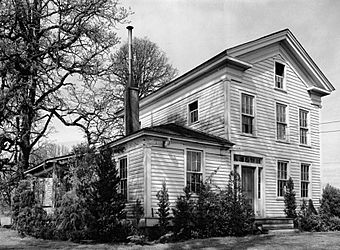Alvin T. Smith House facts for kids
Quick facts for kids |
|
|
Alvin T. Smith House
|
|

Front of house in 1934
|
|
| Location | Forest Grove, Oregon, USA |
|---|---|
| Built | 1854-1856 |
| Architectural style | Greek Revival style |
| NRHP reference No. | 74001721 |
| Added to NRHP | November 8, 1974 |
The Alvin T. Smith House is a historic two-story home in Forest Grove, Oregon, United States. It was finished in 1856. This makes it the second oldest building in the city. The house was added to the National Register of Historic Places in 1974. It was built by a pioneer named Alvin T. Smith. He started building it in 1854. The house is designed in the Greek Revival style.
Contents
A Pioneer Home: The Alvin T. Smith House History
Alvin Smith moved to a large farm in 1841. This area was called the Tualatin Plains. It is now near Forest Grove. Alvin and his wife, Abigail, were the first permanent European-American settlers there. Their first cabin was washed away by a flood. Their second cabin later became a post office.
In 1854, Alvin and Abigail started building a new home. Alvin was a skilled carpenter. He built the house himself. The construction was finished in 1856. This house is the second oldest wooden building in Forest Grove. The oldest is Old College Hall at Pacific University.
Abigail passed away in 1858. Alvin continued to live in the home. He lived there with his second wife, Jane, until 1870. The couple then moved to downtown Forest Grove. However, they still owned the property.
Alvin died in 1888. Jane leased the house to others until she died around 1920. In the 1930s, the Alvin T. Smith House was one of only two buildings in Forest Grove studied for the Historic American Buildings Survey. This survey documents important historical structures.
The Zurcher family bought the house around 1940. The Alvin T. Smith House was officially listed on the National Register of Historic Places on November 8, 1974. The house was left empty around 1990.
In 2002, a group called "Friends of Historic Forest Grove" began plans to buy and fix up the home. They worked with the Oregon Historic Preservation Office. In March 2005, the group bought the house for $75,000. They had raised $175,000 for this project. The long-term goal is to make the property a place to learn about the area's history.
In 2015, Restore Oregon named the A.T. Smith House one of Oregon's Most Endangered Places. This means it was at risk and needed protection.
House Details
The house sits on a 2.2-acre piece of land. It is on the south side of Forest Grove, Oregon. It is located off Oregon Route 47. This area was once a small town called Carnation, Oregon.
The Smith House has a classic Greek Revival design. It has a side hall floor plan. The front of the house is the side with the pointed roof, called a gable. It is a two-story building with a basement. The basement walls are made of stone with brick on top. This kept the basement cool. It was used to store food like fruits and vegetables.
Above ground, the house was built using large, rough-cut logs. These logs were held together with wooden pegs. Alvin Smith cut these timbers by hand using a broad ax. On the main floor, there are many doors between the same rooms. This was so the house could be used for church meetings. In the early days, there were no church buildings. So, religious services were held in people's homes. The house has wood floors. There are two bedrooms on the second floor. All the windows have partitions, meaning they are divided into smaller panes. Most of the original house structure is still there.
About Alvin Thompson Smith
Alvin Thompson Smith (1802–1888) was born in Connecticut. He moved to the Oregon Country in 1840. The next year, he moved to the Tualatin Plains. This is the area that later became Forest Grove.
Alvin Smith was an important person in the early community. He represented the area at the Champoeg Meetings in 1843. These meetings were important for setting up a government in the Oregon Territory. He also helped support Tualatin Academy. This academy later helped to start Pacific University. Smith also served as the local postmaster from 1851 to 1855.
See Also
Images for kids




